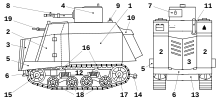NI Tank

The NI Tank (/ˈniː/; Russian: Танк НИ Tank NI, abbr. На Испуг, Na Ispug, literally ‘Bluff into retreat’), also called the Odessa tank or Terror Tank, was an improvised Soviet armoured fighting vehicle, based on an STZ-5 agricultural tractor, manufactured in Odessa during the early days of the German-Soviet War. More than anything this tank was intended to frighten and demoralize enemy positions that believed it to be an actual heavy armored vehicle.[citation needed]
Development

At the beginning of the war between Germany and the Soviet Union, a majority of the factories were evacuated, including most of the equipment from the January Uprising Factory. There was machinery left and it was decided that it would be used to service battle-damaged tanks arriving from the front.
When the army fighting on the outskirts of Odessa (the city defences held out for seventy-two days before the army pulled back) started experiencing shortages in tanks, the workers from the factory decided to build a fighting vehicle of their own design. Aided by the workers from other factories, January Uprising workers built a big metal box and put it on the tractor. Also added was a traversable turret with either a mountain gun or a large-calibre machine gun. The armour was a sandwich of thin naval steel or boiler plate and wood or rubber sheeting to improve protection against small arms. The resulting machine was unlike any other fighting vehicle of the time and made an awfully loud noise when it moved.
Armament was varied, including sub-turrets from T-26 Model 1931 tanks, new turrets with 37 mm Model 15R mountain guns or 45 mm anti-tank guns.
Production history
A total of 68 NI tanks were produced.[citation needed]
Combat use
The first NI left the factory on August 20, 1941. Another two machines were built before it saw its first combat on September 1 in a local engagement on the outskirts of the city. When German troops saw an armoured formation including the unusual looking machines noisily making their way toward them, they retreated back to their starting positions. It was then decided to pull the tanks back to keep their nature secret.
Even though the tanks' speed was a very slow 7 km/h (4.3 mph), their armour was able to withstand small arms fire. In the second half of September, a battalion was formed equipped with NI tanks. In one memorable episode, the tanks entered a village occupied by German troops and while under fire were able to tow away 24 German guns.[citation needed]
See also
- Bob Semple tank, New Zealand indigenous tank design.
- Schofield tank - New Zealand indigenous tank design
- Sentinel tank - Australian indigenous tank design
References
- Tekhnika Molodezhi (1979). "Odesskiy Tank". Retrieved December 30, 2005. (in Russian)
- Zaloga, Steven J., James Grandsen (1984). Soviet Tanks and Combat Vehicles of World War Two, p. 142. London: Arms and Armour Press. ISBN 0-85368-606-8.
External links
- Bronetraktory — Combat tractors, part 3 (in Russian)
| |||||||||||||||||||||||||||||||||||||||||||||||||||||||||||||||||||||||